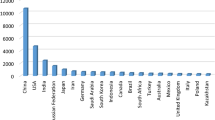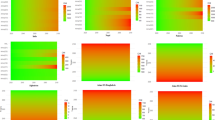Abstract
The first ever increased contribution to the GHG from human activities was due to emissions from agriculture. Because of the large area covered under agriculture and comprehensive practices, the agriculture sector has a significant impact on the earth’s GHG. Therefore, agriculture emissions being one of the main emissions and GHG being the cause of climate change, it is necessary to determine the pattern of emission and forecast of the future. The aim of this paper is to determine the emission pattern from manure management, agriculture soils, enteric fermentation and rice cultivation, also forecasting the emissions. The study object was India. Different univariate time series models were built and best model was selected on the basis of evaluation criteria for forecasting. The performed modelling was based on the FAOSTAT data of India.
Access this chapter
Tax calculation will be finalised at checkout
Purchases are for personal use only
Similar content being viewed by others
References
What is Climate Change?, United Nations, Climate Action. https://www.un.org/en/climatechange/what-is-climate-change
Overview of Greenhouse Gases, United States Environmental Protection Agency (US EPA). https://www.epa.gov/ghgemissions/overview-greenhouse-gases#:~:text=GHG%20emissions%20are%20often%20measured,CO2%2C%20per%20unit%20mass
About the IPCC, The Intergovernmental Panel on Climate Change. https://www.ipcc.ch/
Smith, P., et al.: IPCC report on agriculture, agriculture, forestry and other land use (AFOLU). In: Edenhofer, O., et al. (eds.) Climate Change 2014: Mitigation of Climate Change. Contribution of Working Group III to the Fifth Assessment Report of the Intergovernmental Panel on Climate Change. Cambridge University Press, Cambridge (2014)
Home, Food and Agriculture Organization of the United Nations. https://www.fao.org/home/en/
Samrat, N.H., Islam, N.: Greenhouse gas emissions trends and mitigation measures in australian agriculture sector—a review. Agriculture 11, 85 (2021). https://doi.org/10.3390/agriculture11020085
Lamb, W., et al.: A review of trends and drivers of greenhouse gas emissions by sector from 1990 to 2018. Environ. Res. Lett. 16(7), 073005 (2021). https://iopscience.iop.org/article/10.1088/1748-9326/abee4e
Xu, B., Lin, B.: Factors affecting CO2 emissions in China’s agriculture sector: evidence from geographically weighted regression model. Energy Policy, Elsevier 104(C), 404–414 (2017). https://ideas.repec.org/a/eee/enepol/v104y2017icp404-414.html
Shakoor, A., et al.: Effect of animal manure, crop type, climate zone, and soil attributes on greenhouse gas emissions from agricultural soils—a global meta-analysis. J. Clean. Prod. 278, 124019 (2021). https://doi.org/10.1016/j.jclepro.2020.124019
Wollenberg, E., et al.: Reducing emissions from agriculture to meet the 2 C target. Glob. Change Biol. 22(12), 3859–3864 (2016). https://onlinelibrary.wiley.com/doi/full/10.1111/gcb.13340
FAO: Climate-smart agriculture case studies 2021 – projects from around the world. Rome (2021). https://doi.org/10.4060/cb5359en
IAEA: Greenhouse gas reduction. IAEA, 13 April 2016. https://www.iaea.org/topics/greenhouse-gas-reduction. Accessed 19 Jan 2022
Wasonga, O.V., Olila, D.O.: Climate change, savanna grassland, autoregressive model, time series data (2016). https://www.semanticscholar.org/paper/Climate-change%2C-savanna-grassland%2Cautoregressive-Wasonga-Olila/8fbf81bf357e3b68ed7639d7acf1e4277de49441
Akcan, S., Kuvvetli, Y., Kocyigit, H.: Time series analysis models for estimation of greenhouse gas emitted by different sectors in Turkey. Hum. Ecol. Risk Assess. Int. J. 24(2), 522–533 (2018). https://doi.org/10.1080/10807039.2017.1392233
Hamrani, A., Akbarzadeh, A., Madramootoo, C.A.: Machine learning for predicting greenhouse gas emissions from agricultural soils. Sci. Total Environ. 741, 140338 (2020). https://doi.org/10.1016/j.scitotenv.2020.140338
Gardner, E., McKenzie, E.: Why the damped trend works. J. Oper. Res. Soc. 62, 1177–1180 (2011). https://doi.org/10.1057/jors.2010.37
Author information
Authors and Affiliations
Corresponding author
Editor information
Editors and Affiliations
Rights and permissions
Copyright information
© 2022 The Author(s), under exclusive license to Springer Nature Switzerland AG
About this paper
Cite this paper
Deshpande, A., Belsare, T., Sharma, N., De, P. (2022). Univariate Time Series Forecasting of Indian Agriculture Emissions. In: Singh, M., Tyagi, V., Gupta, P.K., Flusser, J., Ören, T. (eds) Advances in Computing and Data Sciences. ICACDS 2022. Communications in Computer and Information Science, vol 1614. Springer, Cham. https://doi.org/10.1007/978-3-031-12641-3_28
Download citation
DOI: https://doi.org/10.1007/978-3-031-12641-3_28
Published:
Publisher Name: Springer, Cham
Print ISBN: 978-3-031-12640-6
Online ISBN: 978-3-031-12641-3
eBook Packages: Computer ScienceComputer Science (R0)




